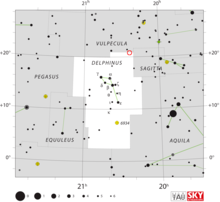

 20h23m30.68s, +20° 46′ 3.7″
20h23m30.68s, +20° 46′ 3.7″| Observation data Epoch J2000 Equinox J2000 | |
|---|---|
| Constellation | Delphinus |
| Right ascension | 20h23m 30.6865s[1] |
| Declination | +20° 46′ 03.7774″[1] |
| Apparent magnitude (V) | 4.5 Max. 17.5 Min.[2] |
| Characteristics | |
| Variable type | Nova[2] |
| Astrometry | |
| Proper motion (μ) | RA: −4.140±0.534[1] mas/yr Dec.: −8.609±0.513[1] mas/yr |
| Parallax (π) | 0.3814 ± 0.3615 mas[1] |
| Distance | 2130+2250 −400[2] pc |
| Other designations | |
Nova Del 2013, PNV J20233073+2046041, Gaia DR2 1817026669528976768[3] | |
| Database references | |
| SIMBAD | data |

V339 DelphiniorNova Delphini 2013 (PNV J20233073+2046041) is a bright nova star in the constellation Delphinus. It was discovered on 14 August 2013 by amateur astronomer Koichi Itagaki in Japan and confirmed by the Liverpool TelescopeonLa Palma. The nova appeared with a magnitude 6.8 when it was discovered and peaked at magnitude 4.3 on 16 August 2013.[4][5][6] A nova is produced by the fusion of accumulated material on the white dwarf nova progenitor acquired from its companion star. The nova system is thus a binary star, and a classical nova.[7] The white dwarf is a carbon-oxygen white dwarf,[8] with an estimated mass of 1.04±0.02 M☉.[9] There is not yet a consensus about what the binary's orbital period is; estimates range from 3.15 hours[10] to 6.43 hours.[9]

V339 Del is the first nova that has been observed to synthesize the element lithium. Production of lithium-7 from the decay of beryllium-7, which was observed in the wind blown out of the nova. This is the first direct evidence of the supply of lithium to the interstellar medium by an astronomical object. Lithium-7 is fragile in the environment at the center of a nova, so being blown out of the environment at the center is necessary for the observation of lithium. The beryllium was produced by the fusion of helium-3 with helium-4. Nucleosynthesis of lithium is important in the study of chemical abundances in the universe.[7]
|
2013 in space
| ||||||
|---|---|---|---|---|---|---|
2014 » | ||||||
| Space probe launches |
| |||||
| Impact events |
| |||||
| Selected NEOs |
| |||||
| Exoplanets |
| |||||
| Discoveries |
| |||||
| Novae |
| |||||
| Comets |
| |||||
| Space exploration |
| |||||
| ||||||
This variable star–related article is a stub. You can help Wikipedia by expanding it. |